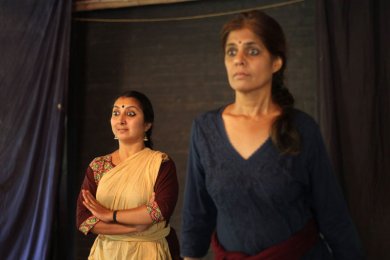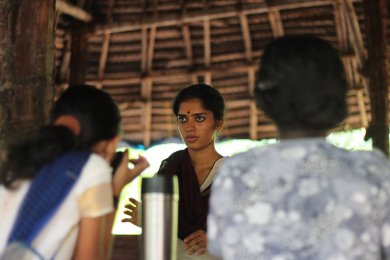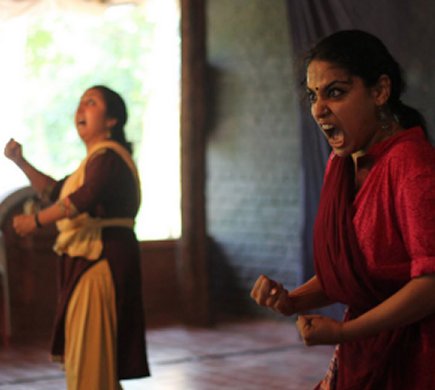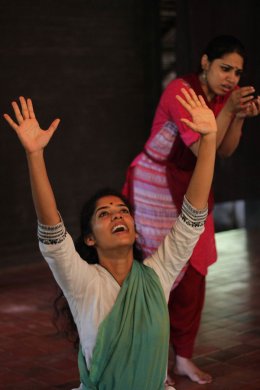
|
 |

|
 |
|
Ascending the ladder of bliss - Payal Ramchandani e-mail: payalssg01@gmail.com December 9, 2017 Rasa can at best be described as the fuel that ignites the soul. There will be no exaggeration in saying that a performance is successful when the audience is transported into a parallel world of emotional consciousness, and hence it is only fair and sensible to get an experiential understanding at a place that provides the expertise, experience and the space. As I stepped into the tranquil premises of Natana Kairali, I felt a deliberate pull into surreally serene zone from one where it could sometimes be challenging to hear the voice of the conscience. However, destiny takes you to places you've never been to and shows you things you never knew of and this workshop was a perfect example of how nature re-establishes this principle time and again. I however must admit here that the silence that enveloped the Natana Kairali campus, which the Venus have put together brick by brick, with so much love and hardship, did bring with it some apprehensions. Having lived for most part of my life in metropolitans, 'quiet' can be slightly unsettling, but not for too long in this case. Apprehensions were tenuously transformed into a firm assurance as we met GopalakrishnaVenu or Venuji as he is lovingly called. Venuji, an epitome of radiance and humility is a self-assured artist with deep seated confidence which comes from years and years of toil fraught with turmoil. Venuji with his years of experience in Kudiyattam and his research and study on different theatre forms across the world fortunately decided to dispel his acquired knowledge on Navarasas amongst the artists' community. Bharata had undertaken the formidable task to lay out in the 6,000 verse treatise - the Natyashastra, what was to describe and prescribe the guidelines and principles of various performing arts traditions to the practitioners of the same. What formed an integral part of this text was the concept of Navarasas which rightly got their exalted status then. However time saw a disappearance of depth and richness in the portrayal of emotions. The methodology devised by Venuji almost a decade back keeping the present day context in mind aims to bring back the profoundness of the rasas in their truest form. 

Navarasa Sadhana finds its roots in the Kodaganallur royalty. The 'Abhinaya Kalari' (or the acting laboratory) of the Kodaganallur palace was the paradise of yore with access to only a few highly devoted sadhakas. Having read about this tradition in the works of Thekkinkattil Ramunni Nair, Pattikkamthodi Ravunni Menon, he was mighty intrigued. However, its intricacies and practical application through detailed approaches were taught to him by his guru, the Late Ammannur Chakyar, who had also honed his acting skills at the palace. Venuji talked to us about the importance of Swara Vayu in the concept of Navarasa Sadhana. Swara Vayu is the sound of the breath. The sound of one's own breath and voice are two extremely essential principles on which Navarasa Sadhana stands and these twenty days at the workshop were to take us through exploring what we often brush aside just as an involuntary action. We were systematically made to experience all the nine emotions namely Sringara (love/beauty), Adhbhuta (wonder), Veeram (valor), Raudra (anger), Bhibhatsa (disgust), Hasya (laughter), Karunam (compassion), Bhayanaka (fear) and Shantam (peace), one by one over a period of twenty days. The most striking aspect of the workshop is the methodology which thrives on the understanding that every participant's experience is his/her own and that it should only be portrayed through one's own uniqueness while abiding by the basic stances/postures needed to invoke a specific rasa. Many of the techniques, facial and eye exercises used in Navarasa Sadhana form the core of Kudiyattam. The starting point to understand the experience of any rasa was to freely walk around imagining and associating oneself with life experiences that at some point in life would have invoked the rasa in question. What breathes life into any act on stage is a clear understanding of the difference between looking and seeing. It is imperative for an artist to use his/her imaginative eye to see and have conviction in what he/she sees. Assigning sensory experiences like smell, taste, touch etc. gives the association a more definitive quality. Stanislavsky, the legendary Russian theatre practitioner, once said, "The actor must use his imagination to be able to answer all questions (when, where, why, how). Make the make-believer existence more definite." It is through these very well defined aspects that the artist creates an imaginary world, which every viewer would therefore swear by and dwell in. 

To delve deep into a rasa, there is an indispensable need to understand the 'sthayi' or the dormant/underlying emotion, because it is this sthayi bhava that gets transformed into a rasa/essence for the spectator and the artist. The rasa depends on the existence of the sthayi bhava, which in turn depends on the Vibhava (determinant), Anubhava (consequence) and Vyabhichari (transitory state). Hence it was only necessary to engage in the process of experiencing the transitory states and little did I know that these would turn out to be the most daunting, disquieting yet intrinsically satisfying experience. Vyabhichari bhavas can be understood as mental reactions or transitory feelings experienced due to a stimulant. We were to come up with imaginatively extreme situations that could exemplify a vyabhichari like Nirveda with its associated vibhavas being 'daridrya' (poverty), 'vyadhi' (disease), 'avamanam' (getting insulted), 'adhikshepam' (abusive language), 'thadanam' (wrathful beating), 'ishtajanaviyogam' (loss of loved persons) and 'thathwagnanam' (knowledge of the ultimate) and for this we were given complete freedom in terms of space, voice, actions with only one guideline …"be extreme." This entire process unveiled a flurry of emotions within me that swirled its way up with every situation I enacted. Catharsis happens when we permit the purging of emotions and this experience enables just that! We sometimes revel so much in the glory of theory that we neglect its visible manifestation in the art form. The sadhana of navarasas is a significant step towards giving these blanketed, forgotten practices due importance. Payal Ramchandani is a Kuchipudi dancer and choreographer. She aims to weave her journey's learnings with her passion for Kuchipudi to enrich her dance. (www.payalramchandani.com) Post your comments Please provide your name and email id when you use the Anonymous profile in the blog to post a comment. All appropriate comments posted with name & email id in the blog will also be featured in the site. |